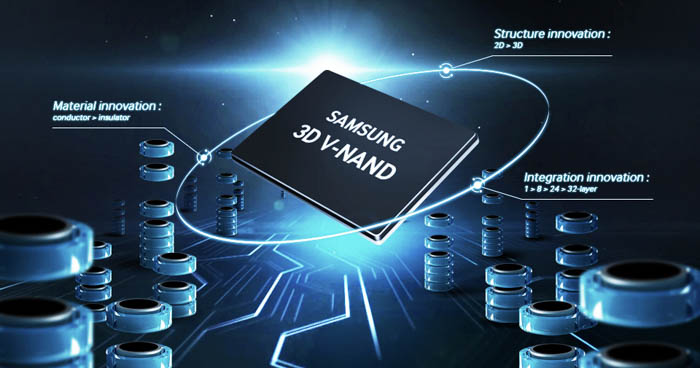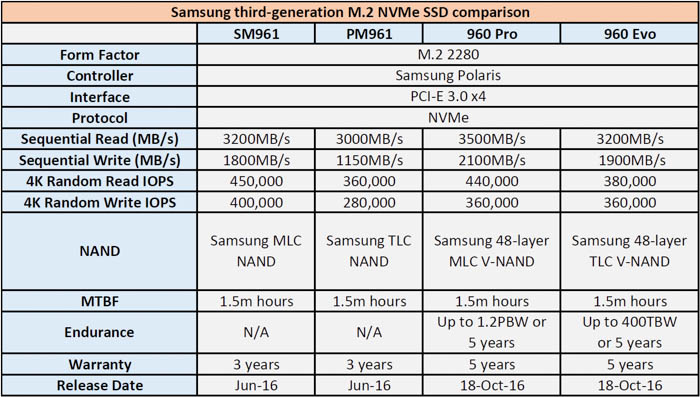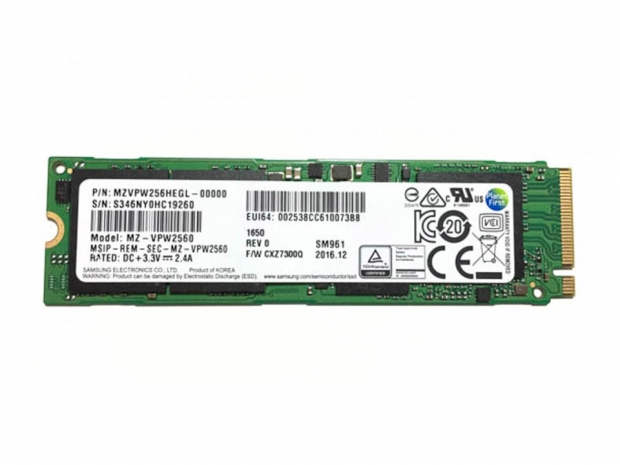Index
48-layer MLC V-NAND delivers more IOPS with low latencies
Last summer, Samsung introduced its first NVMe SSD series based on a new Polaris controller that replaced the UBX controller design from its previous OEM-series SM951 and consumer-oriented 950 Pro SSD lineups, moving ahead with the introduction of 48-layer MLC NAND technology and industry-leading throughput speeds.
In June, we saw the introduction of two new OEM products based on this controller, the Samsung SM961 and PM961 M.2 NVMe drives. While Samsung refers to these as “Client Edition SSDs,” they use the company’s latest in-house, third-generation MLC and TLC NAND flash and advanced in-house Polaris controller to deliver superior performance, exceptional reliability, and minimal power drain, while protecting files with leading-edge data protection.
Fast forward to October, and the company then released its two follow up versions for the consumer market, the 960 PRO and 960 EVO. These are essentially the same drives with the one exception being that they use Samsung’s 48-layer V-NAND technology rather than planar NAND, which ends up giving them a slight performance lead in sequential read and write performance, yet slight performance drops in random read 4K IOPS performance depending on the capacity size. We wanted to take a closer look at how the SM961 OEM models stack up at one of the more popular price-to-performance sizes of 256GB.
Samsung SM961 256GB M.2 2280 NVMe SSD
For this review, we will be testing Samsung’s third-generation SM961 256GB M.2 2280 drive for OEMs. This drive is capable of up to 3,100MB/s sequential reads and 1,400MB/s sequential writes, while delivering 330,000 IOPS in random reads and 280,000 IOPS in random writes. It is currently available at an affordable price of $161.10 on eBay, though often manages to drop by around $15 depending on supply and regional availability. Other features include support for TRIM commands, NCQ, S.M.A.R.T. and end-to-end data protection during power loss.
By contrast, Samsung’s third-generation consumer counterpart of this drive is the 960 EVO 256GB M.2 2280. This drive is capable of up to 3,200MB/s sequential reads and 1,500MB/s sequential writes, while delivering 330,000 IOPS in random reads and 300,000 IOPS in random writes. The drive is currently available at an MSRP of $129 and also includes support for AES 256-bit user data encryption, TCG/Opal, TRIM commands, S.M.A.R.T. and garbage collection.
Note: Performance listed in chart reflects highest capacity model (e.g. 1TB, 2TB)
While most power users and prosumers are likely to prefer the larger 1TB option, this review is geared more towards the mainstream folks curious about M.2 storage upgrade options for 2017, placing emphasis on the value end of the price-to-performance curve in the overall SSD market.
The Samsung SM961 256GB M.2 drive is intended to serve as a drop-in replacement for a two-year old Mushkin Scorpion Deluxe PCI-E 3.0 x4 SSD that was capable of delivering up to 2,150MB/s sequential reads and 1,950MB/s sequential writes, while delivering 51,000 IOPS in random reads and 107,000 IOPS in random writes. That drive is based on a Quad SandForce SF-2281 configuration running through an LSI RAID controller. Within two years, the technology capable of matching or exceeding this type of device has now been shrunk down into an M.2 slot the size of a gumstick with much higher IOPS performance, which is a bit impressive.
M.2 performance now on par with original enterprise NVMe SSDs
Samsung’s first NVMe-based product was announced in July 2013 as the XS1715. This was also the industry’s first enterprise 2.5-inch NVMe device and was capable of delivering up to 3,000MB/s sequential reads, 1,400MB/s sequential writes, and up to 750,000 IOPS in 4K random reads and 115,000 IOPS in 4K random writes.
Samsung proceeded to launch several consumer-oriented M.2 SSD lineups between then and now, including the XP941 in May 2014, followed by the SM951 series in April 2015. Yet these first and second-generation consumer drives could still not match the XS1715 in terms of raw sequential performance – this is where the MLC V-NAND and Polaris controller on the SM961 come into play.




